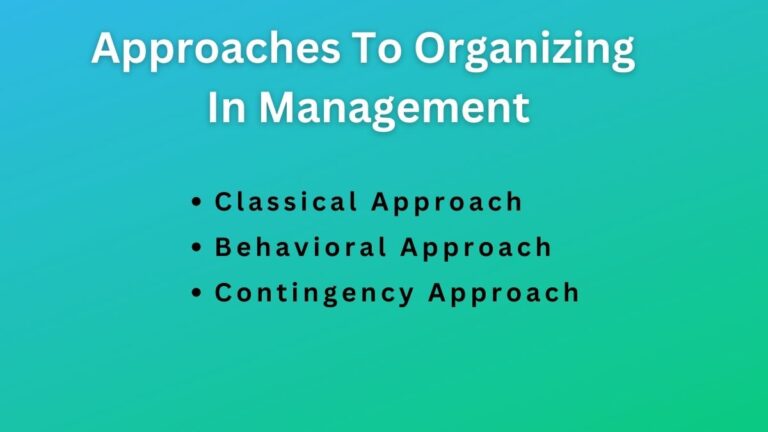What is Management By Objectives (MBO)? Definition, Objective, Process, Success Factors, and Pros/Cons
For the productivity and greater performance of the organization efficient management of employees and other resources is essential. MBO works as a strategic tool to align employees’ and management efforts and goals in the same direction. Management By Objectives (MBO) is similar to participative management but it is more than that. Let’s discuss what the MBO is, its objectives, process, consideration, and pros/cons.
What is Management By Objectives (MBO)?
Management by Objectives (MBO) is the new approach for planning and decision-making in the participation of managers and employees in defining objectives. MBO is a strategic management approach that tries to enhance the performance of the company by clearly outlining objectives that are accepted by management and employees. This will motivate each employee to participate and show dedication.
The term MBO i.e. management by objectives is coined by one of the influential thinkers of management Peter Drucker. It was back in 1954 in his book “The Practice of Management”. This management tool get popularity from 1960 onwards and is still relevant to big organizations.
The MBO strategy improves the alignment of organizational goals across all departments and units, as well as between individuals and those goals. It is becoming increasingly popular as a performance management technique that enables an organization to match the goals of all organizational levels with the goals of its personnel.
It is the joint effort of employees and management in determining the objectives of the organization which fulfills the objectives of both employees and the organization. It is focused more on goals and targets and sometimes devalues the work culture. The MBO strategy fosters the creation of a difficult but attainable goal that supports employee empowerment and motivation.
The major goal of MBO is to promote commitment by giving each employee the chance to concentrate on novel ideas and innovations that advance the goals and objectives of the company.
What is the Objective of MBO?
The main objectives of management by objectives can be mentioned below:
- MBO aims to align the organization’s goals and employees’ goals properly.
- Increase the motivation and commitment of employees to goal achievement.
- Increase the performance at all levels and productivity of the organization.
- Systematically delegate the tasks and responsibilities to each employee and clarify what one has to do and how.
- Fulfill the objectives of both employees and the organization and increase employee satisfaction.
Steps in Management By Objectives Process
Management by objective is the process consisting of a series of interrelated activities. MBO requires the development of a cycle with organizational-level objectives as the beginning point, which must then be translated to the individual level.
MBO is not a one-time exercise. It calls for ensuring that each person actively participates in the development, implementation, and incentive system.
Steps in MBO are simple but vital in implementation as there should be a strong commitment from each individual from each level. Peter Drucker explained the MBO process in the following steps:
Related: Planning Process
Determination and Revision of Organizational Objectives
The starting point of MBO is the strategic level objectives. The organization’s vision, mission, and value statement are used to develop its strategic objectives. This means that organizations should have a clear, concise, and attainable vision, goal, and value statement.
All members of the organization must be able to communicate with and accept such statements. Therefore, defining organizational objectives serves as the first step in the MBO process.
Translating Organizational Objectives To Employees
After defining the organizational objectives, these objectives need to translate to the individual i.e. employee level. For translating objectives to the employee’s level, objectives should be SMART i.e. smart, measurable, attainable, realistic, and time-bound.
Here, while translating the organizational objectives to employees the acceptable element must be taken as this is about the agreement on the objectives between the employees and the organization. According to MBO, objectives should be clearly recognizable at all levels and everyone should know what their responsibilities are in this.
Stimulate Participation of Employees in Objectives Determination
Whatever their level and scope of responsibility, every employee must be involved in setting personal goals for the MBO model to be effectively implemented. Top-level managers must forcefully urge everyone to take part in the discussion and idea-sharing across the entire organization in order to achieve this.
Everyone should make an effort to contribute in order to bring organizational-level goals down to the individual level. Each employee is motivated to find solutions to the issues they encounter when the organization’s decision-making and responsibility are distributed more widely.
This interactive method makes sure that everyone is aware of their own goals in relation to the overall team goals, department goals, business unit goals, and ultimately organizational objectives.
Monitoring of Progress
After ensuring goals and objectives are SMART: encouraging employees for the MBO process, now it is essential to develop a system to measure and monitor the progress. All procedures, issues, and accomplishments must be identified at this phase in order to avoid having a negative influence.
It is done to make sure that employees’ irregular conduct and deviant behavior while creating goals don’t affect the system or progress. It is significant to remember that there may always be exceptions to the rule, and these circumstances should always be closely monitored.
Related: What is Controlling?
In management by objectives, employees must be supported by their management through coaching. Create a clear path with sufficient evaluation moments so that growth and development can be monitored accurately.
Evaluate and Reward Achievements
MBO has been designed to improve performance at all levels within the organization for which a comprehensive evaluation system is essential. There must employee evaluation and reward system to evaluate the performance in relation to the set goals and objectives. There must be an adequate and effective feedback system along with a reward system.
Advantages and Disadvantages of Management By Objectives
Management by Objectives with its various advantages also comes with some disadvantages. Some of its pros and cons are:
Advantages of MBO:
- Employees are aware of their responsibilities at the workplace and they are clear about what is expected of them.
- Ensures a good relationship between management and employees. So effective communication between them is achieved.
- Since everyone of clear about their duties and responsibilities, there is no ambiguity of roles in the workplace.
- Helps to boost performance at every level and increases productivity.
- Employees feel included and motivated and contribute their best efforts.
- MBO ensures efficient management.
Disadvantages of MBO:
- MBO sometimes ignores organizational work culture, ethics, and other considerations since it is more focused on goals and targets only.
- It might increase pressure on teams to reach their goals.
- Setting goals in the MBO process is time-consuming and costly.
- More emphasis on short-term goals.
- For the completion of the MBO program, top management support is essential.
Factors Necessary for a Successful Management By Objectives (MBO) Program
MBO is first introduced by Peter Drucker. He has suggested a number of conditions to fulfill for an effective MBO program which are mentioned below:
- There must be a strong commitment of top-level management to the MBO process and appropriate objectives.
- Objectives are determined with the strong participation of employees. Management and employees should be together in the MBO process.
- Employees’ performance should be conscientiously evaluated against established objectives.
- Objectives are formulated at both quantitative and qualitative levels which can easily be understood by each person.
- Objectives must be challenging and motivating. For this, organizations should be careful to formulate attainable objectives. Much challenging not sure to attain objectives discourages people.
- There must be an effective system for regular feedback on the state of affairs at the level of coaching and development instead of static management reports.
- Varieties of rewards, for example, recognition, appreciation, and/or performance-based pay must be ensured to encourage people in the implementation phase.
- There must be a positive approach to managing people and other activities through growth and development, not punishments.
- It is important to make fair and correct assessments of the achievement against the setting of measurable goals. Clear performance indicators are essential for good management by objective (MBO) program.
Read Next: Participative Management Style
Sajan Kushmi is a content writer with more than 4 years of experience. He holds BIM Degree. He write on the topics related to Management, Marketing, and Entrepreneurship.






